Different Uses Classify 9 Types of Elevators
① Passenger Elevator
Passenger elevators are the kind you find in office buildings, hotels, and other public places. There is a type of elevator that carries people between floors. It is the most common type of lift in the world, and also known as residential elevators, departmental lifts, or simply as lifts or, more colloquially, as elevators.
Passenger elevators are usually made up of two cabins — one for passengers and one for freight — and can carry up to 25 people, depending on the model. Passenger elevators typically travel at speeds of approximately 0.5 to 1 meter per second (1-2 mph), with stops every 20 meters.


② Cargo Elevator
A cargo elevator is a specialized elevator that can carry heavy loads and large items. The design of the freight elevator can accommodate oversized loads, such as furniture or construction materials. This type of elevator is commonly used in warehouses and industrial facilities.
Cargo elevators are also known as platform lifts or platform trucks.
The typical size of a cargo elevator ranges from 8 feet by 8 feet to 14 feet by 14 feet, although some are larger than this range. The size of the elevator depends on what is being carried by it, as well as how many items need to be carried at once.

③ Hospital Elevator
A hospital elevator is a type of elevator that is used in hospitals. It is also a vertical transport device, bed elevator, or lift.
The design of hospital elevators varies depending on their purpose and use. For instance, a hospital elevator may be used to transport patients from their rooms to the operating room. In other cases, it may transport patients between building floors.
Patients who need to be moved from their rooms to the operating room must be able to lie flat in the hospital elevator, so they don’t fall out during transportation. These types of elevators must accommodate beds with wheels attached to them so they can move easily around corners and down hallways without bumping into walls or other obstacles along the way.

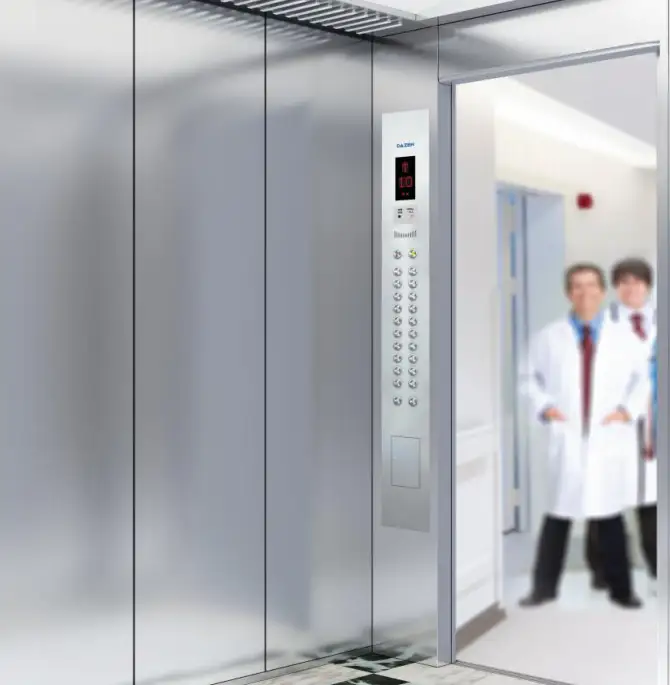
④ Escalators
An escalator is a type of vertical transportation system in the form of a moving staircase – a conveyor that carries people between floors of a building. It consists of a motor-driven chain of individually linked steps that move up or down on tracks, allowing the step treads to remain horizontal.
Escalators are used worldwide to move pedestrian traffic where elevators are impractical. Principal usage areas include department stores, shopping malls, airports, transit systems, convention centers, hotels, and arenas. Escalators are more commonly used than moving walkways when a prolonged continuous path is needed.

⑤ Sightseeing Elevator
Sightseeing elevators carry tourists to the top of a building to view the city. They generally open up at the top of a building and offer tourists the opportunity to view their surroundings from above.
Sightseeing elevators are similar in structure to standard elevators, but they have been modified to accommodate more people and provide a more comfortable trip up and down. The popularity of sightseeing elevators has grown as more cities have become interested in attracting tourists.
A sightseeing elevator can be found at many major tourist attractions worldwide. The Eiffel Tower in Paris is one example of this type of elevator, which can transport up to 20 people at once on its single cab ride up 1,665 feet (508 meters).

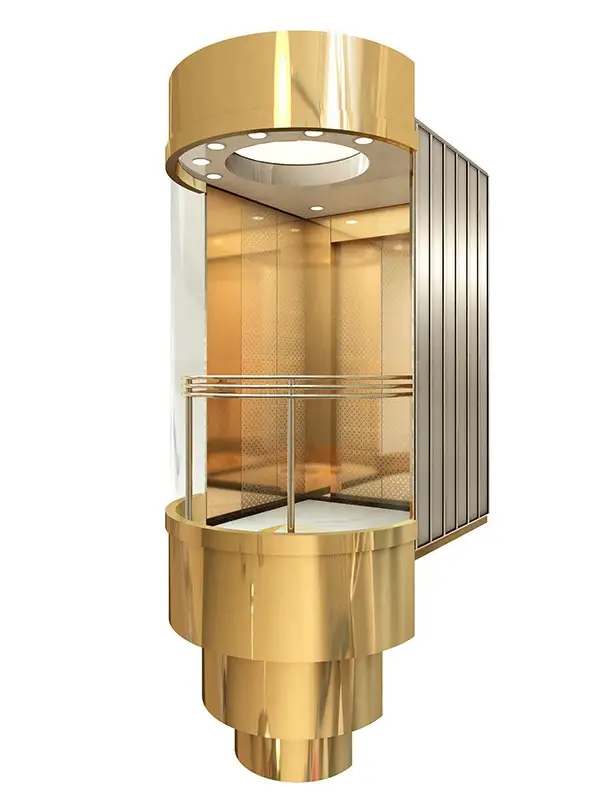
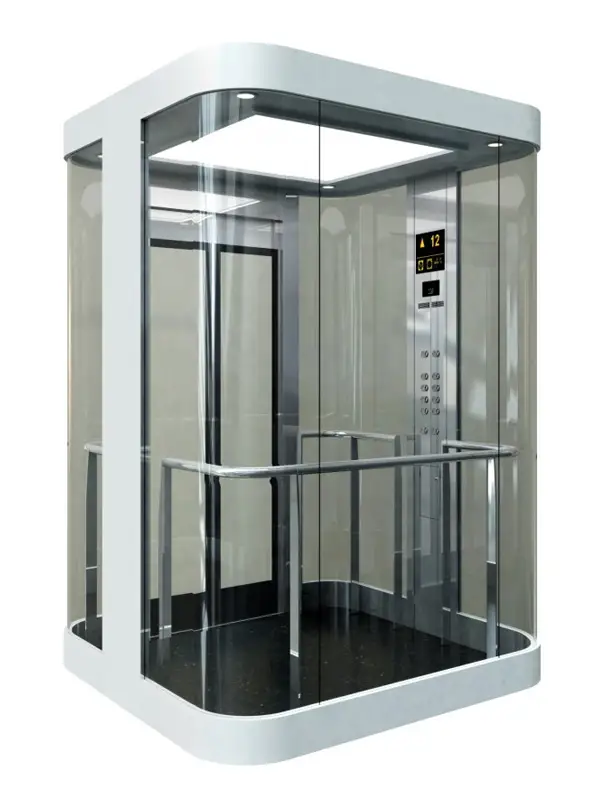
⑥ Home Elevator
A home elevator is a small, portable elevator that can be installed in any residential building. Home elevators are typically used to access floors within a building that are too high for stairs, such as penthouse apartments or basements. Still, they can also be useful for people who need assistance getting around their homes.
Of course, there are far more elevators, and we have listed the 9 most common types of elevators used for 9 different purposes. If you don’t find the right type of elevator, please contact us for the best advice.

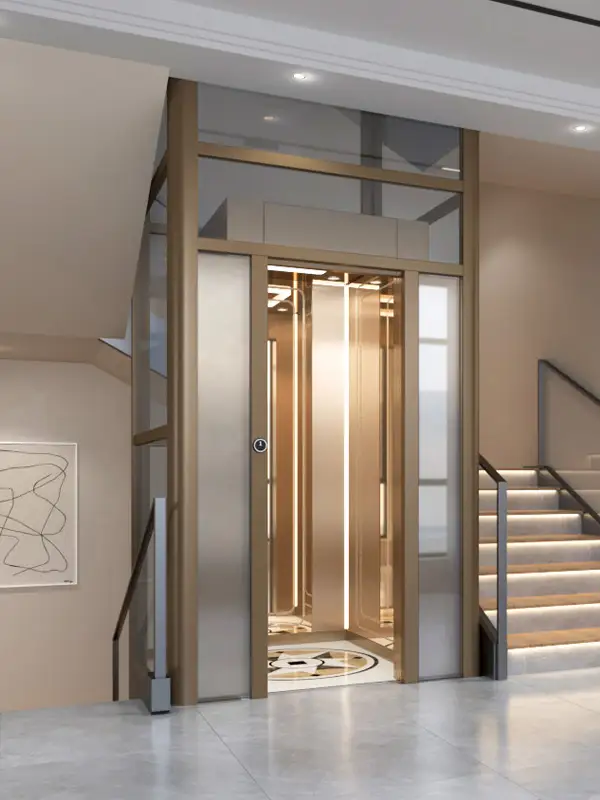

⑦ Vehicle Elevator
A vehicle elevator is a device that moves vehicles vertically and horizontally. A vehicle elevator can be a separate structure or an integral part of the building—the most common elevator transports cars and other vehicles between floors in parking garages. Vehicle elevators are also used in warehouses, factories, and other commercial facilities to move vehicles between different levels.
Vehicle elevators are powered by electricity or hydraulics. Hydraulic lifts are less expensive than electric ones but require more maintenance and have limited speed capabilities. Electric lifts can operate faster and at greater heights than hydraulic lifts if they have enough power available from the building’s electrical system.

⑧ Ship Elevator
A ship elevator is a type of marine cargo elevator used to transport cargo from a ship’s deck to the ship’s bottommost deck.
A ship elevator is usually a large, horizontal steel tray that sits over the side of a ship and can be raised or lowered using ropes and pulleys. The elevator is also connected to an electric motor that can operate remotely from inside the ship.
The first use of a ship elevator was in 1852 when it was installed on HMS Warrior, one of Britain’s first ironclads.

⑨ Construction Elevator
A construction elevator is a type of elevator used in construction projects. It is also known as a scaffolding elevator or a lift.
It is mainly used for building and construction purposes such as transport, goods transportation and access to buildings or areas of buildings that are under construction or repair. Construction elevators are mostly used for transporting heavy materials like concrete blocks, bricks, sandbags and steel bars.
Construction elevators are usually used in buildings that have multiple stories. They can also be used for buildings that have been damaged due to an earthquake or hurricane. The construction elevator allows people to access the upper floors of the building without having to climb stairs or use ladders. This can be very useful in an emergency where people need to move quickly from one floor to another.

Different Drive Methods Classify 6 Types of Elevators
① A.C Elevator
The A.C. elevator is a type of elevator that can be used in high-rise buildings. The main difference between an A.C. elevator and a conventional elevator is that instead of using a D.C. motor, it uses an A.C. motor. The A.C. motor has more torque and power than the D.C. counterpart.
The main benefit of using an A.C. elevator is that it can be run continuously for long periods. This makes it ideal for use in large, high-rise buildings with many people all at once.
② D.C Elevator
A DC elevator is a type of elevator that uses direct current (D.C.) to power its motors. D.C. elevators are commonly used in places with no power grid, such as underground mines and subway stations.
D.C. elevators are also used in older buildings converted from A.C. to D.C. power. If a building originally had A.C. power, it’s much cheaper to convert it to D.C. than to replace the entire system with new wiring and components.
③ Hydraulic Elevator
Hydraulic elevators are a type of elevator that uses hydraulic power to lift the car. A piston is used to raise and lower the car in this type of elevator. This type of elevator is more energy efficient than other types of elevators and allows for more stops than other types of elevators.
Hydraulic elevators are often used in residential buildings because they are cheaper to install than other types of elevators. Hydraulic elevators can also be installed in places that have limited space for an elevator shaft, as well as places where there is not enough room for an electrical generator.
④ Rack and Pinion Elevator
Rack and pinion elevators are a type of hydraulic elevator. They are controlled by a rack and pinion system, which allows the car to move up and down smoothly. The rack and pinion system consists of a metal rail that runs along the top of the elevator shaft and two wheels that ride on either side of this rail. As one wheel moves up or down the rail, it turns another wheel attached to it. This turns the gears in the elevator motor that raise and lower the car.
Rack and pinion elevators are most commonly found in residential buildings, especially in small apartments or condominiums where space is limited. They can be installed inside a building or on an outside wall, providing enough room to fit comfortably without protruding into any other part of your property.
⑤ Screw Elevator
A screw elevator is a device used to transport material up and down a well. It consists of a long cable wound around a large screw at the surface, and the cable is “unwound” as it moves down the well. An electric motor rotates the screw to move the material up or down.
Screw elevators are used for many purposes, including drilling wells for oil and gas, pumping water for irrigation, and raising people out of caves.
⑥ Linear Motor-driven Elevator
A linear motor-driven elevator is used in buildings that are too tall for traditional elevators. It consists of a platform on rails and can travel vertically and horizontally.
Linear motors use electromagnets to produce a magnetic field that moves the platform up or down according to how much current is applied to the magnets. Because the magnets do not move, they do not wear out as gears or cables would, so these elevators can last longer than other types.
Different Speeds Classify 4 Types of Elevators
① Low-Speed Elevator: Less Than 1.0m/s Speed
A low-speed elevator is an elevator that has a maximum speed below 1.00 m/s, or 3.5 ft/s. The International Building Code (IBC) requires that all passenger elevators be low-speed elevators. Low-speed elevators are also called slow-speed elevators, but the terms can be used interchangeably because they have the same meaning. The IBC defines “low speed” as any speed less than 1.0 m/s (3.5 ft/s).
② Medium-Speed Elevator: Speed of 1.0~2.0m/s
The speed of a medium-speed elevator is 1.00~2.00m/s. It can transport passengers from the ground floor to the upper floor in 10 seconds, which only needs two floors in the building. It can be used in residential buildings, offices, hotels, hospitals, etc.
Medium-speed elevator characteristics:
The running time is short, the maximum number of people transported per hour is 1200 persons, and the maximum speed is 150 meters per minute (1 floor).
③ High-Speed Elevator: Greater Than 2.0m/s.
High-speed elevators are elevators that travel at speeds greater than 2.00m/s.
High-speed elevators are used in tall buildings (over 15 stories) where an elevator ride takes more than 30 seconds. The speed is necessary to keep the waiting time minimum, especially in large buildings with many levels of people going up and down all day.
The fastest high-speed elevator in the world travels at 3.1 m/s or about 10 miles per hour. This speed is only possible because of special construction techniques and materials that allow the elevator car to withstand such high speeds without being destroyed by centrifugal force.
④ Super High-Speed Elevator: Speed More Than 5.0m/s.
The high-speed elevator is an electric elevator designed to carry passengers at a speed greater than 5.00m/s (10.00km/h). A super-high-speed elevator is an elevator that travels at speeds of more than 5.00 m/s (16.4 ft/s), or approximately 1,000 km/h (620 mph). It can be used in residential buildings, offices, hotels, and shopping centers.
There are many types of high-speed elevators on the market today:
– The traction machine can reach up to 5 meters per second and is mainly used for residential buildings.
– The screw machine can reach up to 4 meters per second, which is mainly used for office buildings;
– The hydraulic machine can reach up to 3 meters per second and is mainly used for commercial buildings.
Different Working Mechanisms Classify 4 Types of Elevators
① Traction Elevators
Traction elevators are an elevator operated by a cable in a shaft. These traditional elevators are typically used for buildings taller than 12 stories.
Traction elevators use steel ropes and pulleys to move the cab up and down. The cab is connected to a hoist rope attached to an electric motor at the top of the shaft. When the motor turns, it pulls on the hoist rope, which pulls on another rope that runs along at 90 degrees. This second rope is attached to the counterweight or counterbalance weight at the bottom of the shaft, and this weight moves up as well. The weight pushes against the bottom of the cab, so it rises roughly 1 foot per second and falls at about 2 feet per second.

Two Types of Traction Elevators:
1. Geared Traction Elevator: In a geared traction elevator, the motor turns a drive gear directly connected to the hoisting drum. The drive gear has teeth that mesh with a rack. The rack is attached to the hoisting drum and turns it as the motor turns the drive gear. The friction between teeth and rack develops enough force to lift the load or move it upward or downward as required.
2. Gearless Traction Elevator: In a gearless traction elevator, there is no direct connection between the motor and the hoisting drum; instead, a pair of gears is used to transmit power from the motor to the hoisting drum. The first gear has one set of teeth that mesh with another set on the second; this second set has no reverse movement capability but can only rotate in one direction—clockwise or counterclockwise—depending on which way you are going up or down in your building.
② Hydraulic Elevators
Hydraulic elevators are a type of elevator that uses hydraulic power to move the car up and down. Hydraulic elevators are often found in residential buildings, but they’re also used in commercial and industrial buildings.
Hydraulic elevators work by using pressurized oil instead of electricity. The oil is stored in a tank on the roof of the building. As the car moves up or down, pistons push and pull the car in the appropriate direction. Hydraulic elevators can travel faster than other types, but they’re less efficient because they require more energy than other elevators.
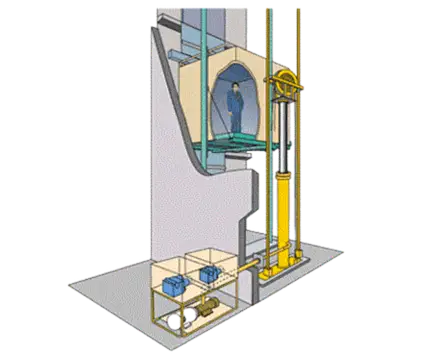
Three Basic Types of Hydraulic Elevators:
1. Gearless: A gearless elevator has no gears inside the machine itself; instead, it uses gears outside the machine to transfer power from an electric motor into motion. Gearless elevators are usually found in older buildings because they’re less expensive than other types of hydraulic elevators. However, they’re also less efficient than other types because they require more energy and maintenance than newer models.
2. Gear-type: A gear-type elevator has gears and hydraulics inside its machinery; it uses hydraulics to raise and lower the cab but relies on gears for speed control rather than the electric motor. Gear-type elevators are more efficient than gearless models because they use hydraulics for speed control rather than an electric motor.
3. Compound hydraulic elevators: Compound hydraulic elevators have both gearless and gear-type systems combined into one unit. Compound hydraulic elevators tend to be larger than other hydraulic elevators because they have to house gears and pulleys inside the machine instead of just one set, as with a simple hydraulic elevator.
③ Machine-Room-Less (MRL) Elevators
Machine room-less (MRL) is a marketing term for elevators that do not require a separate machine room for the elevator’s electrical and control equipment. In general, this means that all the equipment is located in the cab (or, in some cases, in an attached cab), with only the main drive motor located outside the cab.
The MRL elevator combines the functionality of both a shaft-less elevator and a machine-room-less elevator into one product. It can be installed without any major modifications to your building’s structure, which makes it ideal for retrofitting older buildings or creating new ones that require high-rise elevators.
This Arrangement Has Several Advantages:
1. It reduces weight by eliminating heavy external gearing. This allows for lighter cabs, which reduces maintenance costs and increases safety.
2. It reduces noise by eliminating noisy gearboxes.
3. It reduces heat generation by eliminating moving parts (except for the main drive motor). This is especially important in high-rise buildings where elevator shafts can be long and hot enough to fry an egg on a hot summer day.
④ Vacuum (Air-Driven) Home Elevators
Vacuum elevators, also known as air-driven lifts and pneumatic elevators, are a type of elevator that uses compressed air to raise and lower passengers. They operate in an enclosed shaft filled with a partial vacuum, allowing the car to float to the desired floor.
Vacuum (air-driven) elevators can be installed in any building and can travel up or down. They are also great for homes with limited space because they have no large motors or shafts to clutter up your living area.
The main advantage of this type of elevator is its quiet operation. The motor operates at a lower speed than other types of elevators and therefore produces less noise.
Another advantage is that vacuum (air-driven) elevators are safer than hydraulic ones because they do not require any oil or water to operate them. This means that if there were ever a fire or other emergency in your building, you would still have access to all areas of your building, even if the power went out!

Frequently Asked Questions
What type of elevator is the fastest?
The fastest elevators can reach a speed of 10 meters per second (33 feet per second), or about 45 miles per hour. This is just a little less than the average speed of a car driving on the highway.
The fastest elevator ever built is the Hitachi-Otis Express elevator which travels at 64.8 km/h (40 mph).
The Otis Elevator Company introduced this new high-speed elevator in 2003. The fastest elevators in the world are installed in Guangzhou’s Sky City, which is expected to be completed by 2016. These elevators will travel at 606 meters per minute (m/min), or about 1,685 feet per minute (ft/min). That’s over 40 miles per hour!
What is a standard lift?
In the field of elevator technology, the standard lift is a term used to describe an elevator that meets all applicable safety standards. These standards may vary by country, but the most common one is the ASME A17.2-2001, a U.S. government standard published in 2001 and updated in 2009.
What is a lift elevator?
A lift or elevator is a type of vertical transportation that moves people or goods between floors of a building, vessel or other structure. Lifts are typically powered by electric motors that drive traction cables or counterweight systems like a hoist or pump hydraulic fluid to raise a cylindrical piston like a jack.
They are commonly referred to as “lifts” in the United States; the term “elevator” is used in American English. Lifts are commonly found in residential buildings such as apartment blocks and hotels, where they can provide essential access to upper floors and roofs.
How to choose the elevator that meets your needs?
When choosing an elevator, it’s important to understand exactly what you want the elevator to do.
Elevator manufacturers offer several different types of elevators based on how they are used. The type of elevator you choose will depend on the size and shape of your building, how much traffic it will see, and how many floors it needs to move between.
Choose a freight elevator if you need to transport heavy loads within a building. Freight elevators are often installed in large commercial buildings like warehouses or manufacturing plants. They can be installed in residential buildings as well, but aren’t usually common in homes or apartments because they’re big and noisy.
Choose a passenger elevator if you need to transport people between floors in a building with multiple stories. Passenger elevators are commonly found in residential buildings like apartments, condominiums and townhouses where there are multiple floors and only one stairway leading from each level to another.
Choose an escalator if you want people to move quickly between floors without having to take stairs — like when there is a high volume of foot traffic in an office building or shopping mall during certain times of day (like lunch hour). Escalators can also be found at airports where large numbers of people need to get between the land side and the terminal. Escalators are also popular in hotels, where they can be found moving guests between the lobby and upper floors.
What are the best elevator manufacturers in the world?
Ever wondered who makes the best elevators? Your friends have heard about Mitsubishi, Schindler, ThyssenKrupp, and KONE. But how trustworthy are their opinions? As an elevator enthusiast, I’ve compiled research on the top 20 elevator manufacturers worldwide to create a list of reliable names you can trust.

Final Thoughts
One of the most important things to remember when shopping for an elevator is that they are not all made equal. Buying a used elevator can be a nice option if you don’t have any other choice, but you must know exactly what you’re getting into before you sign on the dotted line. If safety is your number one priority (as it should be), purchasing a new elevator from a reputable company that stands behind its product may be best. Consider your financial situation and make sure you can afford to pay for repairs and maintenance.
We hope that this guide has been beneficial and that you found it useful in selecting a particular type of elevator. If you have any questions or requests, please get in touch with us at WhatsApp / Tel:+8615189717159, or email us at info@dazenelevator.com. We look forward to helping you soon.
